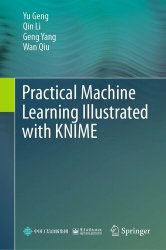Practical Machine Learning Illustrated with KNIME
- Добавил: literator
- Дата: 31-08-2024, 07:37
- Комментариев: 0
 Название: Practical Machine Learning Illustrated with KNIME
Название: Practical Machine Learning Illustrated with KNIMEАвтор: Yu Geng, Qin Li, Geng Yang, Wan Qiu
Издательство: Springer
Год: 2024
Страниц: 312
Язык: английский
Формат: pdf (true)
Размер: 37.5 MB
This book guides professionals and students from various backgrounds to use Machine Learning in their own fields with low-code platform KNIME and without coding. Many people from various industries need use Machine Learning to solve problems in their own domains. However, Machine Learning is often viewed as the domain of programmers, especially for those who are familiar with Python. It is too hard for people from different backgrounds to learn Python to use Machine Learning. KNIME, the low-code platform, comes to help. KNIME helps people use Machine Learning in an intuitive environment, enabling everyone to focus on what to do instead of how to do.
This book helps the readers gain an intuitive understanding of the basic concepts of Machine Learning through illustrations to practice Machine Learning in their respective fields. The author provides a practical guide on how to participate in Kaggle completions with KNIME to practice Machine Learning techniques.
The distinctive feature of this book lies in its emphasis on graphical explanations, using visual representations to make complex ML principles more intuitive. By incorporating KNIME, a graphical ML tool, we make learning more accessible for beginners, eliminating the daunting prerequisite of programming.
Our “top-down” approach structures the content with a clear narrative on ML models, supported by two threads that align with our educational philosophy. The first thread involves mastering KNIME from an overall workflow to detailed operations, while the second transitions from a macro understanding of ML to the mastery of specific skills. The textbook focuses on graphical understanding of algorithms and application-oriented operations using KNIME, without delving into complex theoretical formulas. Hands-on mastery, another key feature, is demonstrated through the participation in Kaggle competitions, ensuring learners master ML processes, model configurations, data cleaning, and handling imbalanced datasets.
This textbook aims to provide a comprehensive and accessible introduction to AI and ML. It is structured into three parts: Introduction to AI Technology, Traditional Machine Learning, and Deep Learning. The first part lays the groundwork of essential knowledge, the second part explores various ML models and techniques, and the concluding part introduces the basics of Deep Learning.
Primarily crafted for beginners, this textbook is also a valuable resource for anyone interested in the practical applications of AI and ML. Our aspiration is that readers will, in the spirit of Caesar’s renowned quote, “Veni Vidi Vici,” truly come, see, and conquer the basics of ML.
The Chapter 1 offers a comprehensive overview of Artificial Intelligence (AI) and Machine Learning (ML), essential for understanding these transformative technologies in the modern era. Beginning with a historical perspective, it charts the evolution of AI from its conceptual origins in the late 1930s to its present-day advancements. The discussion encompasses key milestones such as the Dartmouth Conference, the rise and fall of expert systems, and recent breakthroughs in deep learning and neural networks. The chapter also delves into the essence of Machine Learning, highlighting its three primary types: supervised, unsupervised, and reinforcement learning. It illustrates how these methods are pivotal in pattern recognition and predictive analysis, forming the backbone of current AI applications. Additionally, the chapter explores the intersection of machine learning with traditional statistical methods, shedding light on their similarities, differences, and complementary roles in data analysis. Through this chapter, readers gain a clear understanding of AI’s capabilities and limitations, its historical context, and its potential future trajectory.
Contents:
Скачать Practical Machine Learning Illustrated with KNIME
Внимание
Уважаемый посетитель, Вы зашли на сайт как незарегистрированный пользователь.
Мы рекомендуем Вам зарегистрироваться либо войти на сайт под своим именем.
Уважаемый посетитель, Вы зашли на сайт как незарегистрированный пользователь.
Мы рекомендуем Вам зарегистрироваться либо войти на сайт под своим именем.
Информация
Посетители, находящиеся в группе Гости, не могут оставлять комментарии к данной публикации.
Посетители, находящиеся в группе Гости, не могут оставлять комментарии к данной публикации.

